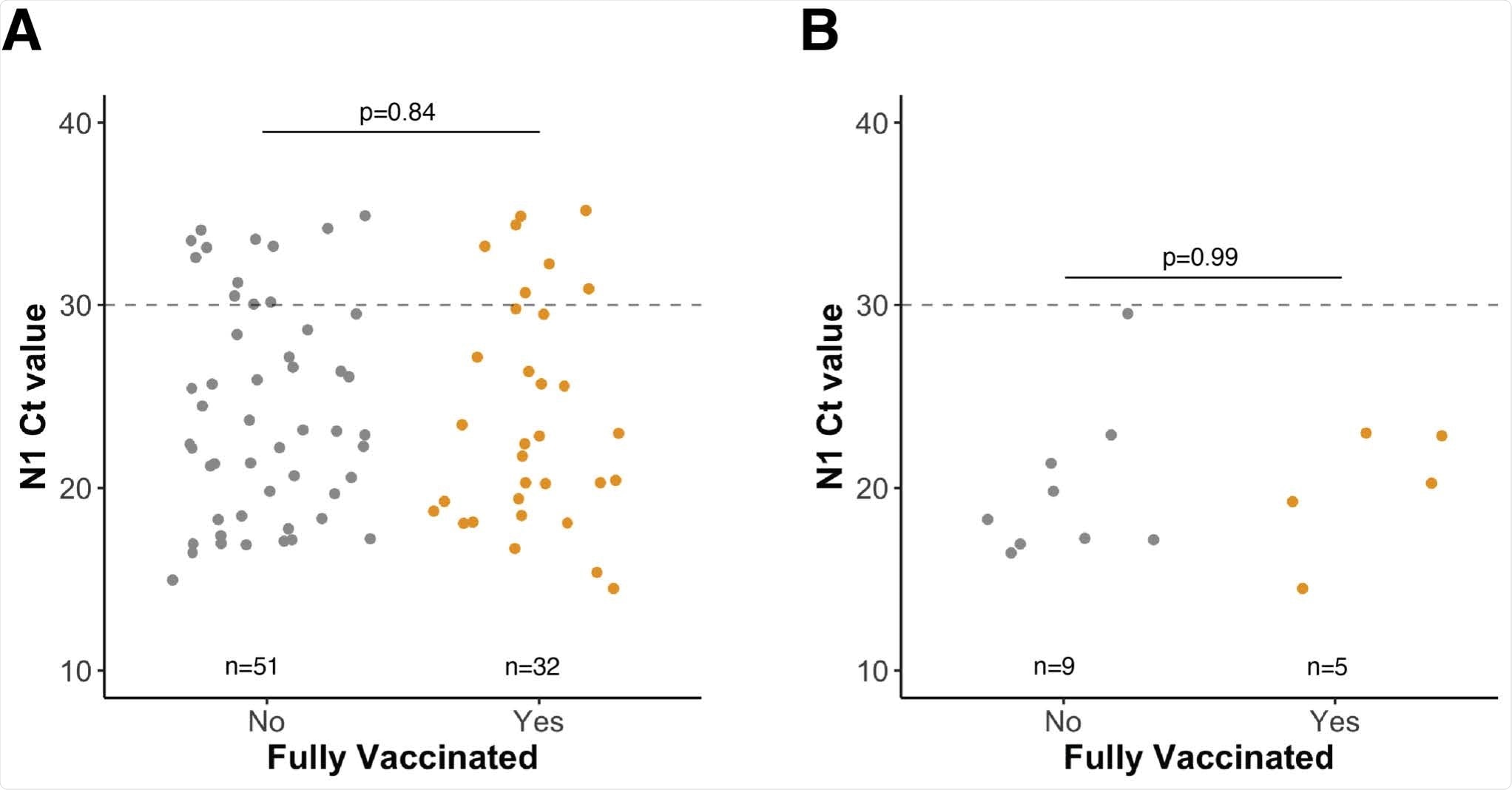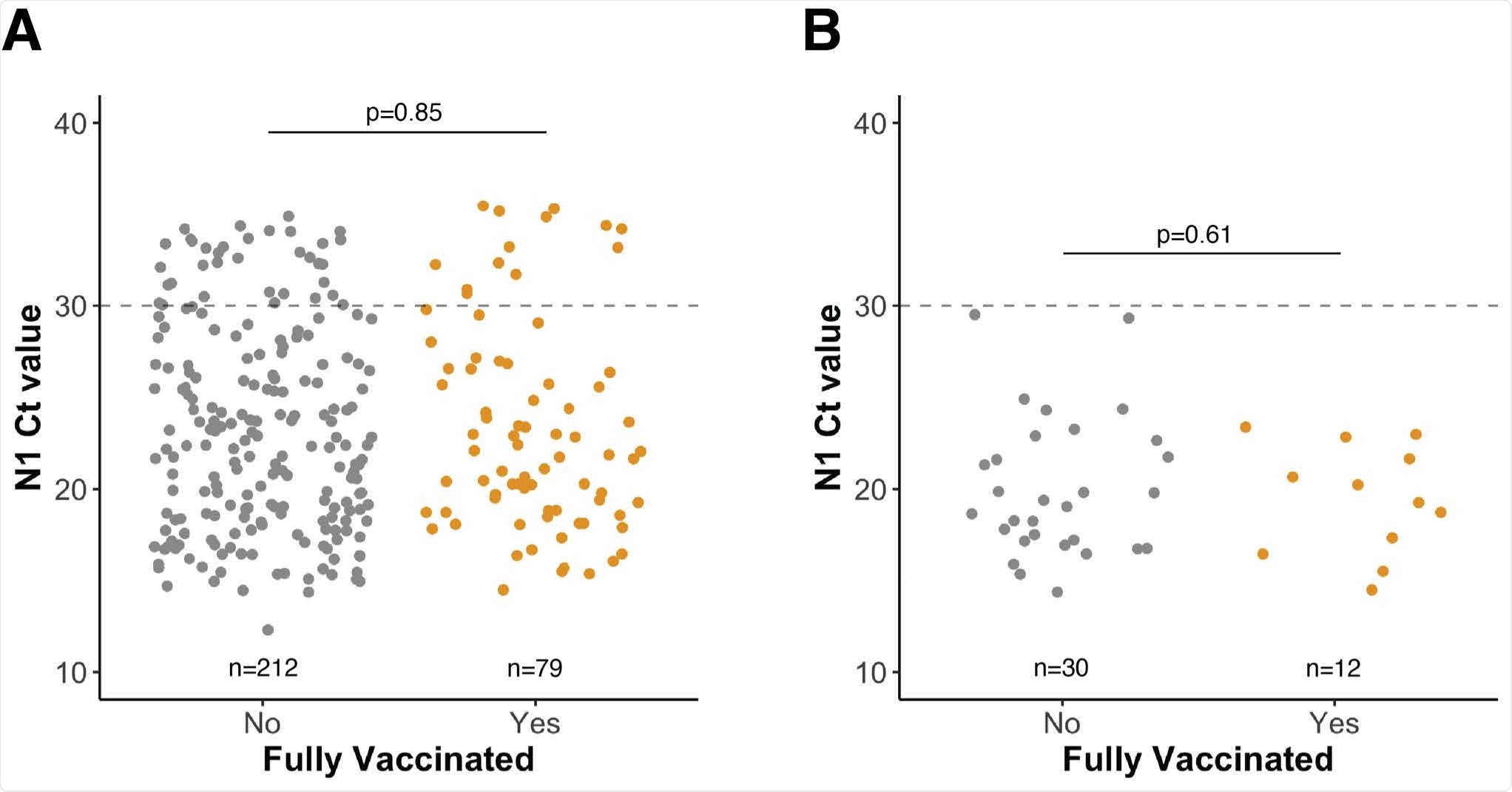A US-based study has recently compared the viral load in vaccinated and unvaccinated individuals who have been infected with the delta variant of severe acute respiratory syndrome coronavirus 2 (SARS-CoV-2).
The findings reveal that vaccinated and unvaccinated individuals exhibit similar viral loads following delta infection and that vaccine breakthrough cases have the potential to transmit infection to others. The study is currently available on the medRxiv* preprint server.
.jpg)
Study: Vaccinated and unvaccinated individuals have similar viral loads in communities with a high prevalence of the SARS-CoV-2 delta variant. Image Credit: NIAID
Background

 This news article was a review of a preliminary scientific report that had not undergone peer-review at the time of publication. Since its initial publication, the scientific report has now been peer reviewed and accepted for publication in a Scientific Journal. Links to the preliminary and peer-reviewed reports are available in the Sources section at the bottom of this article. View Sources
This news article was a review of a preliminary scientific report that had not undergone peer-review at the time of publication. Since its initial publication, the scientific report has now been peer reviewed and accepted for publication in a Scientific Journal. Links to the preliminary and peer-reviewed reports are available in the Sources section at the bottom of this article. View Sources
Viral breakthrough infections occur when vaccinated individuals become infected with the pathogen against which the vaccine was developed. Following immunization, ideally, a vaccine is expected to completely inhibiting viral replication by inducing “sterilizing immunity.” However, not all intramuscular vaccines made against respiratory viruses -- including the Coronavirus disease 2019 (COVID-19) vaccine -- result in sterilizing immunity. These vaccines are expected to provide protection against symptomatic disease, severe disease, and death. In this context, vaccine-mediated reduction in viral load is believed to play an essential role in reducing disease severity and controlling person-to-person viral transmission.
In the current study, the scientists evaluated whether COVID-19 vaccines can reduce viral loads in vaccine breakthrough cases. Specifically, they have compared the viral load in SARS-CoV-2-positive samples collected from 83 individuals in Dane County, Wisconsin, which has exceptionally high vaccine coverage compared to other populated counties in the United States.
Based on the self-reported vaccination status and dates of complete vaccination, the scientists divided the participants into two groups: the fully vaccinated group with 32 individuals and the unvaccinated group with 51 individuals. Then, as a “convenient proxy” of viral load estimation, they used polymerase chain reaction (PCR)-generated threshold cycle (Ct) values to compare viral loads between vaccinated and unvaccinated individuals who have been infected mostly with the SARS-CoV-2 delta variant (B.1.617.2).
The delta variant of SARS-CoV-2, first identified in India, has caused a sharp increase in COVID-19 cases globally. Compared to other viral variants, the delta variant has significantly higher infectivity and is partially resistant to antibody-mediated neutralization.

Viral loads for Dane County specimens are independent of vaccination status. A) N1 threshold cycle (Ct) values for SARS-CoV-2-positive specimens grouped by vaccination status. B) N1 Ct values for SARS-CoV-2-positive specimens confirmed to be delta variants by sequencing. In A and B, the horizontal dashed line represents the threshold for consistent recovery of infectious virus as well as our Ct cut-off for sequencing specimens. Sequence data were available only for specimens collected on or before 16 July 2021, not all samples had a Ct < 30, and not all samples with a Ct < 30 sequenced successfully, accounting for the relatively low number of delta confirmed sequences. P-values were calculated by comparing mean Ct values between groups by Welch two sample t-tests. Data from the Dane County cohort are shown.
Important observations
The respiratory samples used in this study to estimate viral load were collected during July 2021, when the delta variant was predominantly circulating worldwide and the number of new COVID-19 cases was increasing in the United States.

Viral loads for the expanded Wisconsin cohort, including Dane County, are independent of vaccination status. A) N1 cycle threshold (Ct) values for SARS-CoV-2-positive specimens grouped by vaccination status. Specimens were collected from 11 Wisconsin counties. B) N1 Ct values for SARS-CoV-2-positive specimens were confirmed to be delta variants by sequencing. In A and B, the horizontal dashed line represents the threshold for consistent recovery of infectious virus as well as our Ct cut-off for sequencing specimens. Sequence data were available only for specimens collected on or before 16 July 2021, not all samples with a Ct < 30 were sequenced successfully, and not all were delta, accounting for the relatively low number of delta confirmed sequences. P-values were calculated by comparing mean Ct values between groups by Welch two-sample t-tests. Data from the expanded Wisconsin cohort, including Dane County, are shown.
Based on the Ct values, no significant difference in viral load was observed between fully vaccinated and unvaccinated individuals. Of all collected samples, 16 were sequenced to identify viral variants. The delta variant was identified in the majority (88%) of sequenced samples, indicating a high prevalence of this variant in Dane county.
For further analysis, additional 208 samples from other Wisconsin counties were included. Of a total of 291 samples from all counties, 73 were associated with vaccine breakthrough cases. About 84% of vaccine breakthrough cases exhibited Ct values less than 30, which indicates the presence of infectious virus in respiratory samples. Similar Ct values were estimated in 83% of unvaccinated individuals with SARS-CoV-2 infection. Surprisingly, about 33% of vaccine breakthrough cases exhibited very high viral loads with Ct values less than 20.
Based on the genetic sequencing data, the delta variant was identified in 84% of all tested samples. This further indicates a high prevalence of the delta variant in Wisconsin during the study period. Based on this information, the scientists assumed that the delta variant caused almost all infections considered in the study.
Study significance
Taken together, the study findings indicate that the delta variant of SARS-CoV-2 is capable of inducing infection even in fully vaccinated individuals and that a significant proportion of vaccinated individuals with breakthrough infections are capable of transmitting the virus to others.
In Dane county, almost 68% of the population is fully vaccinated. Unfortunately, despite high vaccine coverage, a high percentage of vaccine breakthrough infections with high viral loads have been detected in this county. This finding further highlights the need for frequent testing and continuous adherence to non-pharmacological control measures to limit the community-level spread of SARS-CoV-2.

 This news article was a review of a preliminary scientific report that had not undergone peer-review at the time of publication. Since its initial publication, the scientific report has now been peer reviewed and accepted for publication in a Scientific Journal. Links to the preliminary and peer-reviewed reports are available in the Sources section at the bottom of this article. View Sources
This news article was a review of a preliminary scientific report that had not undergone peer-review at the time of publication. Since its initial publication, the scientific report has now been peer reviewed and accepted for publication in a Scientific Journal. Links to the preliminary and peer-reviewed reports are available in the Sources section at the bottom of this article. View Sources
Journal references:
- Preliminary scientific report.
Riemersma KK. 2021. Vaccinated and unvaccinated individuals have similar viral loads in communities with a high prevalence of the SARS-CoV-2 delta variant, medRxiv, doi.org/10.1101/2021.07.31.21261387, https://www.medrxiv.org/content/10.1101/2021.07.31.21261387v1
- Peer reviewed and published scientific report.
Riemersma, Kasen K., Luis A. Haddock, Nancy A. Wilson, Nicholas Minor, Jens Eickhoff, Brittany E. Grogan, Amanda Kita-Yarbro, et al. 2022. “Shedding of Infectious SARS-CoV-2 despite Vaccination.” Edited by Florian Krammer. PLOS Pathogens 18 (9): e1010876. https://doi.org/10.1371/journal.ppat.1010876, https://journals.plos.org/plospathogens/article?id=10.1371/journal.ppat.1010876
Article Revisions
- Mar 14 2023 - The preprint preliminary research paper that this article was based upon was accepted for publication in a peer-reviewed Scientific Journal. This article was edited accordingly to include a link to the final peer-reviewed paper, now shown in the sources section.